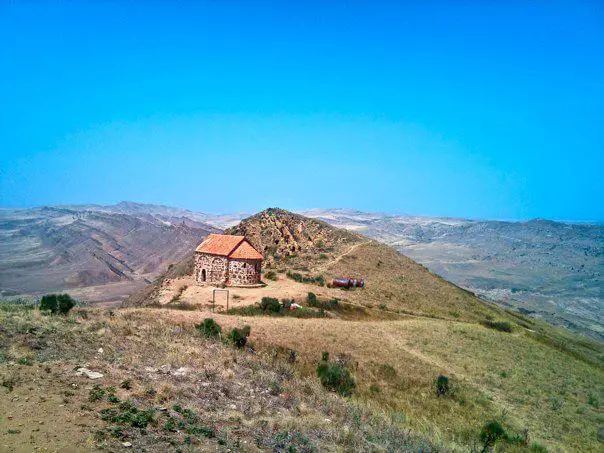Situated up on a mountainous ridge overlooking the desert plains of Azerbaijan are a group of abandoned caves that shelter one of Georgia’s art treasures – the frescoes of the Davit Gareji school.

Georgia may be considered as a part of Europe, albeit one of its most eastern frontiers, but its art history differs significantly from its Western European counterparts like Italy or the Netherlands. Up until the 18th century, easel painting didn’t really exist in Georgia; instead Georgian art mostly took on the form of murals and frescoes that dot the country’s various monasteries and churches.
Various national schools with their own unique styles sprung up around the South Caucasian country, which not only celebrated Georgian hagiography, but also drew influences from the cultural contacts they had with their neighbouring countries.
One of the most important fresco schools of Georgia’s golden age was at the rock-hewn Davit Gareji monastic complex perched the country’s southern border with Azerbaijan.


The monastery complex became Georgia’s sacred spiritual and cultural centre. It was a place where the translation of manuscripts took place and also birthed the once flourishing Davit Gareji fresco school.


The Davit Gareji complex is situated in the middle of nowhere between the southern steppes in Georgia and the Azeri desert, with nothing but a bad road and (at least in our case) a battered old taxi to get you there.
Even after a bumpy ride through the dry grass-covered steppes and through ghost towns populated with unfinished concrete structures, the journey hasn’t finished yet. The Lavra monastery is located right next to the car park, but it’s a place of holy residence and not a tourist
 centre. We were allowed into the courtyard to enjoy to look at the sandstone caves from afar, but no further – since a colony of monks still resided on the premises.
centre. We were allowed into the courtyard to enjoy to look at the sandstone caves from afar, but no further – since a colony of monks still resided on the premises.
Reaching Udabno itself was more complex, as it involved an hour-long hike up the mountainside to reach the ridge housing the abandoned caves. Even at 11am the temperature reached over 35°C, going up by five degrees when we stepped onto the path overlooking Azerbaijan. Scrambling the dirt path up we kept looking to the ground beneath our feet to make there were no poisonous vipers in the way.
The site had been a subject for political debate due to its proximity on the Georgian-Azeri border, and getting to the caves of Udabno can mean you may unintentionally cross into Azeri territory, as we did at the top of the ridge, but fortunately, Kalashnikovs aside, they Azeri border guards were friendly and helpful guys.

Standing among the silence of dried shrubs rustling in the wind, it’s hard to imagine the gunshots fired once by the Soviet army as they shot at the hill for artillery practice in preparation for Afghanistan. Or picture the hordes of Persian invaders in the 17th century attacking the monastery.
We scrambled along the path, peeking into caves at frescoes depicting Georgian saints and their stories, till the path climbed up the ridge to a flat outcrop. We wandered along, trying to figure out how to find the taxi in the car park again – wondering whether he would still be there. A couple of lone huts sat overlooking the desert when two young men in uniform with a dog, wielding a pair of kalashnikovs walked up to us.

“Welcome to Azerbaijan, do you know you’ve crossed the border?” they asked us in English.
We panicked, looked to each other for support till I stepped forward and told them we got lost and could they help us find the path back to the car park.

One of the men smiled and pointed to a path leading down the other side of the hill, where the vegetation looked greener. “You can go back to Georgia that way,” he pointed. Relieved we thanked them and scrambled down, finding a thread of a stream that cut down the rock that led back to Lavra. Under a dried out tree, we saw our old taxi still parked, with the driver smoking a cigarette, looking away from us.
